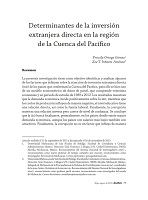Determinants of Foreign Direct Investment on The Pacific Rim Region
DOI:
https://doi.org/10.32870/mycp.v5i14.507Keywords:
foreign direct investment, Pacific Rim, economic, human capital, corruptionAbstract
Focusing in Pacific Rim countries, this article aims to identify and analyze the influencers to attract foreign direct investment (FDI). Using panel data for foreign direct investment between 1989 and 2012, we find that fdi was affected positively by economic demand, while production costs influenced negatively; the education levels had a direct relationship, as well as the workforce. Finally, corruption showed an inverse relationship, but lacks confidence level. We conclude that fdi seeks generally located in countries whit greater economic demand, although countries with lower wages are also attractive. Finally, corruption is not a factor affecting forcefully on decisions of investors in the Pacific Rim countriesDownloads
References
Amparo Tello, D. (2001), “El foro de Cooperación Económica de Asia-Pacífico ¿la formación de un régimen internacional?”, México y la Cuenca del Pacífico, 4(13), pp. 7-11.
APEC. (2011), APEC Economic Policy Report. Disponible en: http://publications.apec.org/publication-detail.php?pub_id=1153 Consultado: 20 de mayo de 2015.
APEC. (2012), APEC at a glance. A dvancing Free Trade for A sia-Pacific Prosperity (S/N), Disponible en: http://apecmrc.epa.gov.tw/RI/RI019.pdf Consultado: 20 de mayo de 2015.
APEC. (2015), Base de datos estadísticos Stats APEC. Disponible en: http://statistics.apec.org/ Consultado: 20 de mayo de 2015.
Baltagi, B. H.; Egger, P. y M. Pfaffermayr. (2008), “Estimating Regional Trade Agreement Effects on fdi in an Interdependent World”, Journal of Econometrics, 145(1), pp. 194-208.
Dabat, A. (2009), “La crisis financiera en Estados Unidos y sus consecuencias internacionales”, Problemas del Desarrollo Revista Latinoamericana de economía, 40(157), pp. 39-74.
Dunning, J. (1988), “The Eclectic Paradigm of International Production: A Restatement and some Possible Extensions”, Journal of International Business Studies, 19(1), pp.1-31.
Egger, P. y H. Winner (2005), “Evidence on Corruption as an Incentive for Foreign Direct Investment”, European Journal of Political Economy, 21(4), pp. 932-952.
Galindo M. M. A. (2008), “La crisis económica estadounidense”, Boletín Económico de ice, Información Comercial Española (2946), pp. 13-22. Disponible en: http://www.revistasice.com/cachepdf/BICE_2946_1322 FC80BC656A5098E0F85B9445B87E0656.pdf
Gligo, N. (2007), Políticas efectivas para atraer inversión extranjera directa en América Latina y el Caribe, serie Desarrollo Productivo, núm. 175, Chile, Naciones Unidas, cepal, pp. 1-131. Disponible en: http://archivo.cepal.org/pdfs/2007/S0700049.pdf
Granados, U. (2014), “México y el Acuerdo de Asociación Transpacífico (TPP): oportunidades y retos”, México y la Cuenca del Pacífico, 3(6), pp. 55-76.
Habib, M. y L. Zurawicki (2002),” Corruption and Foreign Direct Investment”, Journal of International Business Studies, 33(2), pp. 291-307.
Hymer, S. H. (1960), The International Operations of National Firms: A Study of Direct Foreign Investment. Disponible en: DSpace@MIT http://dspace.mit.edu/handle/1721.1/27375
Ivanova, A.; Rangel, E.; Celaya, R. y A. Gámez, (2012), APEC: más allá del comercio. Cómo el mecanismo de Cooperación Económica Asia-Pacífico contribuye al desarrollo sustentable, la ciencia y la formación de recursos humanos, México, Senado de la República-uabcs-Universidad de Colima, México.
Jones, G. (1988), “Foreign Multinationals and British Industry before 1945”, The Economic History Review, 41(3), pp. 429-453.
Jordaan, J. (2008), “State Characteristics and the Locational Choice of Foreign Direct Investment: Evidence from Regional FDI in Mexico 1989–2006”, Growth and Change, 39(3), pp. 389-413.
Hunter, W.; Kaufman, G. y T. Krueger (ed.), (1999), The Asian Financial Crisis: Origins. Implications and Solutions, Chicago, Estados Unidos, Springer Science + Business Media, LLC.
Lim, E. G. (2001), Determinants of, and the Relation between, Foreign Direct Investment and Growth: A Summary of the Recent Literature, Washington D.C., International Monetary Fund.
Malem, S. J. (2000), Globalización, comercio internacional y corrupción. Barcelona, España, Gedisa.
Moran, T. H. (2005), “How does fdi affect Host Country Development? Using Industry Case Studies to make Reliable Generalizations”, en T. H. Moran, E. Graham y M. Blomström (ed.), Does Foreign Direct Investment promote Development, Washington D.C., The Peterson Institute for International Economics, pp. 281-313.
Morrisey, O. (1999), “The Emperor is Fully Clothed, if a Little Ragged: East Asian Miracles and Crises”, Journal of the Asia Pacific Economy, 4(2), pp. 214-232.
N.U. CEPAL - Unidad de Inversiones y Estrategias Empresariales (2012), La inversión extranjera directa en América Latina y el Caribe (s/n). Disponible en: http://repositorio.cepal.org/bitstream/handle/11362/1151/S2013381_es.pdf?sequence=1
OEDC. (2015), OECD.stat. Base de datos estadísticos. Disponible en: https://stats.oecd.org/ Consultado: 30 de mayo de 2015.
Ortega, P.; Cruz A. y J. Alcaráz (2010), “Competitividad para la atracción y localización de la inversión extranjera directa en México”, ponencia, IV Congreso Internacional sobre Competitividad Internacional, en J. Sánchez (presidencia), La competitividad como factor de éxito, Puerto Vallarta, Jalisco.
Ramírez, M. (2000), Foreign Direct Investment in Mexico: A Cointegration Analysis, The Journal of Development Studies, 37(1), pp. 138–62.
Ramírez Bonilla, J. J. (2014), “El TPP vis-à-vis el RCEP: ventajas y desventajas de ambos proyectos”, México y la Cuenca del Pacífico, 3(6), pp. 17-53.
Rodríguez A. (2001), “La inversión extranjera directa en las principals economías de APEC y su relevancia para México”, México y la Cuenca del Pacífico, 4(14), pp. 45-50.
Samford, S. y P. Ortega (2014), “Subnational Politics and Foreign Direct Investment in Mexico”, Review of International Political Economy, 21(2), pp. 467-496.
Smarzynska, B. K. y S. J. Wei (2000), Corruption and Composition of Foreign Direct Investment: Firm-level Evidence (Informe 7969), National Bureau of Economic Research. Disponible en: http://www.nber.org/papers/w7969.pdf
Secretaría de Economía (2014), Estadísticas sobre inversión extranjera directa. Disponible en: www.economia.gob.mx/ Consultado: 10 de diciembre de 2014.
UNCTAD. (2013), Informe sobre las inversiones en el mundo, wir, 2013, Las cadenas de valor mundiales: inversión y comercio para el desarrollo (s/n). Disponible en: http://unctad.org/es/PublicationsLibrary/wir2013overview_es.pdf Consultado: 30 de mayo de 2014.
UNCTAD. (2014), UNCTADSTAT. Disponible en: http://unctadstat.unctad.org/wds/ReportFolders/reportFolders.aspx Consultado: 17 de mayo de 2015.
United States Department of Labor (2015), Bureau of Labor Statistics. Disponible en: http://www.bls.gov/ Consultado: 30 de mayo de 2015.

Downloads
Published
How to Cite
Issue
Section
License
Open Access Policy
This journal provides open access to all its contents, in adherence to the principle that making research freely available supports a greater global exchange of knowledge.
MyCP is licensed under a Creative Commons Attribution-NonCommercial license, also known as CC BY-NC.
Contents are published in both PDF and XML formats.
Authors who publish in México y la Cuenca del Pacífico must accept the following conditions:
Pursuant to Mexican copyright laws, México y la Cuenca del Pacífico acknowledges and respects the authors’ moral right and ownership of property rights, which will be assigned to the University of Guadalajara to publish the articles in an open-access mode.
México y la Cuenca del Pacífico does not charge the authors any fees for receiving and processing their articles.
Authors are permitted to enter into other independent and additional contractual agreements for the non-exclusive distribution of the article version published in México y la Cuenca del Pacífico (for example, publishing it in an institutional repository or in other printed or electronic media) as long as they clearly state that the piece was originally published in México y la Cuenca del Pacífico.
Pursuant to the above, once the article is approved for publication, authors must send the Assignment of Rights Agreement form duly filled and signed. This form must be sent to mexicoylacuenca@gmail.com as a PDF file.
Readers/users of México y la Cuenca del Pacífico can freely access the journal new issues as soon as they are uploaded. Readers/users are allowed to cite, share (both electronically and physically), print and distribute the material, provided they expressly state that the work was originally published in México y la Cuenca del Pacífico. Contents are to be properly cited and never for commercial purposes.




